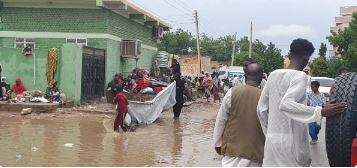The United Nations Office for the Coordination of Humanitarian Affairs (OCHA) on Sunday morning said an estimated 317,000 people (56,450 families) have been affected by heavy rains and flooding in 60 localities across 16 states in Sudan, since the onset of rains in June.
According to the Sudan Floods Dashboard, this includes an estimated 118,000 people who have been displaced, reports the International Organization for Migration Displacement Tracking Matrix (IOM DTM) Floods Update 02. The most affected states include North Darfur (76,095), followed by River Nile (58,825), Northern (53,924), and West Darfur (28,230).
“The Sudan floods dashboard reports that 39 people have been killed, 112 people have been injured, 26,918 homes have been destroyed, and 31,236 homes have been damaged due to the heavy rains and flooding. Actual numbers are likely much higher,” OCHA’s flash update stated. “The risk of disease outbreaks due to the flooding and subsequent stagnant flood waters is high across affected states. Recently, the Sudan Ministry of Health has confirmed 556 cholera cases with 27 associated deaths across Kassala, Gedaref, Aj Jazirah and Khartoum states.”
OCHA however stated that the reopening of the Adre border crossing from Chad into Darfur is expected to enable humanitarians to deliver emergency food and nutrition supplies, medicine, shelter, and other life-saving assistance to millions of people in desperate need of assistance, especially in Darfur.
Floods in eastern Sudan
Field reports indicate that more than 32,370 people have been affected by heavy rains and flooding in eastern Sudan since the onset of the rainy season in June. This includes an estimated 13,843 people in Kassala, 16,868 people in Red Sea, and 1,662 in Gedaref, most of whom fled recent hostilities in Sennar State.
“The rains damaged 190 tents accommodating about 950 people in gathering sites in Kassala town. In addition, 33 schools in Kassala town, Reifi Gharb Kassala, Halfa Aj Jadeedah, and Refi Aroma localities have been damaged depriving over 23,000 children of access to education facilities,” the update stated. “In Red Sea State, partners have reported that the rains have damaged tents, latrines, and drainage systems and caused the loss of food stocks. The actual number of people affected is believed to be higher as authorities and humanitarian partners continue to assess the impact of heavy rains and flooding among host communities, refugees, and internally displaced persons (IDPs).”
Floods in River Nile and Northern states
Floods in River Nile and Northern states have caused extensive damage displacing thousands and creating critical needs across health, water, sanitation, and shelter sectors. The flooding also resulted in widespread scorpion and snake infestations, posing further risks to the community due to the shortage of venom serum. The floods also destroyed annual crop stocks, impacting the main livelihood practices of farming, animal husbandry, and daily wage labor. Additionally, the flooding risks bringing cyanide from nearby mining areas are endangering human health, animals, and the environment.
“In River Nile State, the health and water, sanitation and hygiene (WASH) situation in areas along the River Nile is dire, with contaminated water, destroyed latrines, and a severe shortage of scorpion venom serum,” OCHA reported. “The floods reportedly damaged 150 public buildings, and compromised more than 32,200 latrines, according to partners. The Sudan Floods Dashboard reports that 11,381 homes have been destroyed and 384 homes have been damaged. Rural areas are among the worst affected, with entire villages inundated or inaccessible.”
It added: “Agricultural damage and livestock losses remain unknown, while mining and water contamination further complicate the situation. There is an urgent need for tents, non-food items (NFIs), medical waste management, emergency drugs, and awareness campaigns, with some areas only accessible by boat.”
In Northern State, the floods have reportedly swept scorpions into homes. Due to a critical shortage of venom serum in the state deaths from scorpion stings were reported, according to partners. Destruction of private and public infrastructure has been widely reported including 3,255 homes destroyed, and 7,504 homes damaged, according to the Sudan Floods Dashboard. In addition to damaging government and public facilities, the floods have also disrupted transportation, cutting off roads between Dongola and Halfa in several locations, including Dalgo Al Mahas, Akasha, and Al Beer. Despite these challenges, the Emergency Department, in coordination with local authorities, is actively working to address the damage, prevent further harm, and combat potential disease outbreaks, all while managing the impact of a severe hurricane in Dabba locality.
Humanitarian response
According to OCHA, humanitarian partners are working with the authorities to respond to the immediate needs of people affected by floods across the country. Humanitarians have provided temporary shelter, food, non-food items (NFIs), water, sanitation and hygiene support (WASH), as well as health and nutrition services.




